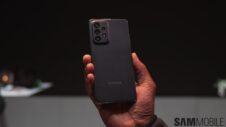2023 is almost here. In a couple of months, Samsung will unveil its brand new Galaxy S23 series of flagships, no doubt followed by its usual barrage of mid-range and budget smartphones until it's time for the launch of its next foldable flagships in the second half of 2023.
As you would expect, Samsung launched plenty of products in 2022, as well. Samsung offered many choices so everyone could pick their poison. The Galaxy S22 series, the Galaxy A53 5G, the Galaxy Z Fold 4, and the Galaxy Z Flip 4 all made a splash as far as Samsung's smartphone offerings are concerned. The Galaxy Watch 5 is impressive, too.
Now, those devices were all excellent in their own right, but what would we consider the best Samsung offering in 2022? Well, as we mention in the title, the best and most impressive thing about Samsung this year was its software update policy, or rather, the way it handled software updates.
No amount of praise for Samsung's handling of updates in 2022 is enough
Yes, we're once again trying to praise Samsung's handling of the Android 13 and One UI 5.0 update, but we have our reasons. As we said above, Samsung launched quite a few smartphones that had something to offer to everyone, but let's face it: none of them came close to being perfect, either in their own right or as upgrades to their predecessors.
Take the Galaxy S22 series. 2022 brought a big change to Samsung's premier flagship line: the Korean giant finally decided to use Qualcomm's latest Snapdragon processor for most markets. But Samsung also released the Galaxy S22, S22+, and S22 Ultra with an Exynos chip in many markets — mainly those in Europe. And we know that Exynos chip (the Exynos 2300) ended up causing all sorts of problems for customers.
Those problems were mostly performance and stability related, and while the One UI 5.0 update has alleviated some of those problems, the fact remains that the Galaxy S22 series fell short like other Galaxy S smartphones in the last couple of years. Again, it's all thanks to that Exynos chip – and frankly speaking, the Snapdragon 8 Gen 1 that was used in countries outside Europe wasn't that great, either.
The Snapdragon 8+ Gen 1 processor that came a few months later was much better. It was used in the Galaxy Z Fold 4 and the Galaxy Z Flip 4 worldwide, and the two foldables gained excellent performance and battery life, both areas that were a little weak in previous models. Overall, though, neither device was a huge upgrade. Furthermore, both foldables ask you to make some sacrifices, especially the Z Flip 4 with its lackluster camera setup.
Then there's the Galaxy A53 5G. It succeeded the highly popular and well received Galaxy A52 from 2021, but once again, things weren't perfect. Samsung's switch to an Exynos processor for the A53 was partly to blame. Performance on the A53 was not up to the mark initially, and it was only with software updates, including the one that brought Android 13 and One UI 5.0, that Samsung was able to make the necessary improvements.
But if there's one thing in common across all these phones, it's that Samsung's software policy was extremely consistent. Android 13 and One UI 5.0 arrived for them real quick, and while there are some countries where the update has not yet been released, Samsung still did an outstanding job overall. And not just for the devices we mention here, but for most devices that were eligible for Android 14.
Basically, we have to be honest: While we here at SamMobile will always prefer using a Samsung Galaxy phone, none of Samsung's 2022 smartphones will be getting too many (or any) phone of the year awards by other experts or anyone who follows Samsung's products and the mobile industry in general.
But what no one can deny is that Samsung killed it with the Android 13/One UI 5.0 rollout. The update arrived much, much quicker than we thought, and it was also virtually bug-free, which is an extremely rare combo and makes Samsung the undisputed king of updates, a crown the company is likely to hold on to for a long time.


![[Video] Discover all the advanced features on your Galaxy phone or tablet!](https://www.sammobile.com/wp-content/uploads/2024/07/Samsung-One-UI-advanced-features-226x127.jpeg)




